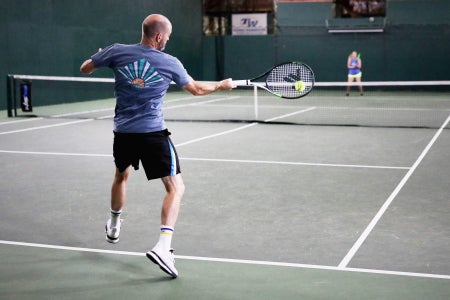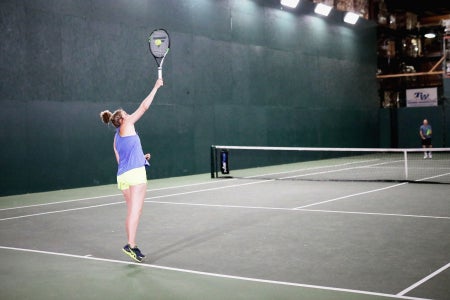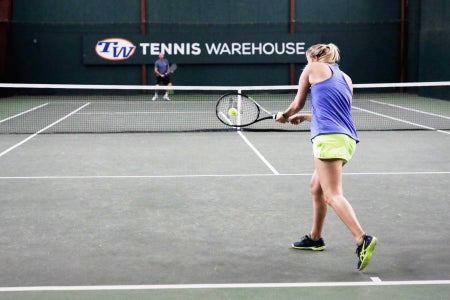Tecnifibre TFlash 300 CES Racquet Review
| Groundstrokes | 81 |
|---|---|
| Volleys | 82 |
| Serves | 80 |
| Returns | 80 |
| Power | 84 |
| Control | 79 |
| Maneuverability | 83 |
| Stability | 80 |
| Comfort | 81 |
| Touch/Feel | 79 |
| Topspin | 83 |
| Slice | 84 |
The Tecnifibre TFlash 300 receives some spec and tech changes in its fifth generation. The TFlash 300 CES features Tecnifibre’s Progressive String Pattern, which features tighter spacing in the center mains for more control and wider spacing on the outer mains for better comfort. The shape of the beam is also thicker and more angular thanks to Cubic Edge Shaft (CES) technology. For extra shock absorption and a cleaner feel, HD Fused Grip silicone was added around the handle. The result of these changes is an increase in swingweight from the previous Power Stab model's 313 to 320 in this update, and it was a change our playtesters definitely noticed. On the upside, they found a more stable response, though some testers thought the new racquet wasn’t as quick or whippy as its predecessor. Serving was definitely preferred over returning for our playtesters, who enjoyed the TFlash 300 CES's extra power and spin potential. All in all, Tecnifibre's TFlash 300 CES continues to be a solid option for players at the intermediate through advanced levels seeking easy power and spin.
Upsides
- Power
- Stability
- Responsive feel
Downsides
- Less maneuverable than the previous version
Bottom Line
This updated TFlash 300 still packs power, along with improved feel and stability, but it's also less maneuverable.
Ability
Intermediate to advanced
Groundstrokes - Score: 81
Our team of playtesters found the Tecnifibre TFlash 300 CES to offer better stability and more heft than the previous Power Stab version. Mark considers himself a counterpuncher, and the way a racquet performs from the baseline is very important to him. He said, "Looking at the numbers, I expected the new Tecnifibre TFlash 300 CES to be pretty lively from the baseline since it closely follows the modern player's racquet formula. For my baseline game, this was an impressive stick that produced big smiles. I was able to develop an effective level of both pace and spin on the ball with the TFlash 300 CES, and its compact yoke made it very easy to change the direction of the ball. Throughout the many 11-point groundstroke games I played during this playtest, the only time I got into trouble was when my opponent's pace and depth were exceptional."
Because the previous version was at one time his racquet of choice, Chris was excited to see what this update had to offer. He compared, "I liked the comfort and the feel of this update to the TFlash 300. I thought both were improved over the Power Stab version. The racquet came through the ball with more stability too. On the flip side, the previous version is more maneuverable, which gives me easier access to spin, angles, and quick injections of pace. The difference felt like more than just an increase in swingweight, and I wondered if the redesigned yoke was making it harder to get the racquet to rotate. When I hit with this update I struggled with my flick angle forehand and also when I was looking to keep my racquet head speed up in defensive situations. I was never able to be as creative with my shot making, which is the thing I love most about playing with the previous version. On the plus side, I could block shots better with it, I felt more connected to my touch shots, and I liked how I could hit a more driving slice backhand."
"I have played with the last couple generations of the TFlash line and have always found them user-friendly, with easy power and depth," continued Brittany. "So it came as a surprise when I picked up this CES update and required an adjustment period to find my timing. I noticed the higher swingweight right away, and I felt that there was more weight in the hoop of the racquet. On the positive side, this change increased the stability, and I felt it had better plow through. On the other hand, I thought the maneuverability was worse, and I was having trouble whipping the racquet around my body and creating spin."
Jason had a similar experience to Brittany. He added, "As a standalone playtest, I'd consider this racquet pretty maneuverable, but it felt a bit sluggish compared it to the previous version. I thought I was able to get good depth and spin on my shots, but it was slightly tougher to find sharp angles on either wing. With the new Progressive String Pattern, I felt like control was improved compared to the Power Stab model."

Volleys - Score: 82
The TFlash 300 CES impressed our team on volleys with its responsive, solid feel. Chris raved about the performance of the update up at net. He said, "If there was an area where I preferred the TFlash 300 CES over the 300 PS version, it was at net. I liked how much more solid this racquet felt. Both comfort and feel also seemed improved. Again, the previous version felt faster and easier to maneuver, but this new TFlash 300 was still plenty maneuverable. When punching volleys, I found the power level to feel very familiar. Thanks to the racquet's power I was able to dispatch high volleys and overheads with ease."
"Maneuverability-wise, the TFlash 300 CES was easy for me to get into position for a volley, and the racquet felt very responsive at contact," added Mark. "My volleys were strong from most anywhere on the court, and it was not until ball speeds were excessive that the TFlash 300 CES ever quivered in my hand."
Jason was also pleased with the performance of the TFlash 300 CES. He noted, "For being a low 11-ounce racquet, it felt pretty solid and stable up at net. Even with some off-center shots, I thought the torsional stability was better than anticipated. There was also plenty of put-away power on overheads and sitter volleys."
Unlike the other playtesters, Brittany had mixed feelings when it came to volleying. She explained, "On one hand, I never felt like I was getting pushed around with this racquet. I could punch my volleys firmly deep in the court to end the point. However, I also had to be very conscious of where the racquet was in relation to my body and make sure I had my hands out in front at all times. I needed to prep a little earlier than usual so I wouldn't be late to the ball. Nonetheless, I found enough feel to hit a variety of volleys."

Serves - Score: 80
Serving proved to be one of our team’s favorite parts of the TFlash 300 CES playtest. Mark was impressed with the racquet when starting points. He commented, "My serve was nicely complemented by the TFlash 300 CES, which was a welcome surprise to me since I usually prefer heavier racquets for this particular shot. There wasn’t a devastating level of pace on my serve with this racquet, but it was offensive enough for me to use the shot as a setup for the rest of the point. Of all the shots, the serve was probably my favorite with this racquet."
Chris also served well with the TFlash 300 CES. He said, "Getting power and spin was not a problem since I found it easier to get the racquet through the hitting zone than I did on groundstrokes. My flat serves had solid pace. When hitting with spin, I was able to attack wide with slice or topspin. Even on second serves, I started points aggressively and felt very confident with this racquet."
Jason especially enjoyed hitting first serves. He said, "I was getting pretty good pop off my serves thanks to the open string pattern. I liked the way I served with this stick."
Like with her groundstrokes, Brittany had to make some adjustments on serves. She described, "I found myself being more cautious than normal on serves, and just like groundstrokes, I had an acclimation period before finally feeling comfortable. For whatever reason, I wasn't able to snap my wrist, and the first couple times I served, I was hitting long a lot. Gradually, I was able to rein in my shots and start being aggressive on my first serve, going for smaller targets. I liked hitting slice serves out wide and flatter serves up the T. I was even able to get a couple of extra free points per match with my first serve toward the end of the playtest."

Returns - Score: 80
Our playtesters had mixed results returning with the TFlash 300 CES. Jason, who probably had the most success, noted, "The access to spin allowed me to confidently swing away at slower serves. I wasn't launching as many balls long thanks to the tighter string pattern in the sweetspot. Chipping and blocking bigger serves back with depth was no problem. I'd say that finding sharp angles was a little harder with this racquet compared to the previous Power Stab model."
On the other hand, Chris didn’t find the TFlash 300 CES as versatile as he would have liked. He said, "I liked the solid response of this racquet when driving my returns. I was able to place the ball deep with solid pace, and control my block returns well. I could float them deep to buy some time or drop them short to draw my opponent in. When I was looking to whip an angle return I wasn't able to work the ball like I can with the previous version. I couldn't be as creative with my cross-court returns in singles or doubles, and I found myself relying more on straight drives."
"Normally, I prefer to return over serve. With the TFlash 300 CES this was not the case," Brittany critiqued. "I felt I had a little more control on my serve and was a little more erratic on my return. I wasn't getting the racquet around my body fast enough, and I was hitting a lot of returns late. To cut down on my errors I aimed down the middle on first serves and aimed for safer targets on my more aggressive second serve returns."
Mark was left craving more mass in the racquet. He concluded, "This was the one area of my game where I wanted the TFlash 300 CES to be slightly heavier. Maneuverability was top-notch from anywhere in the court, but my return was more often a chip instead of topspin, and that is where the heavier setup would have come in handy."
Overall - Score: 81
| Technical Specifications | ||
|---|---|---|
| Length | 27 in | 69 cm |
| Head Size | 100 sq in | 645 sq cm |
| Weight | 11.3 oz | 320 g |
| Balance Point | 12.8 in 33 cm | 6 pts Head Light |
| Construction | 25mm / 26mm /26mm | |
| Composition | Graphite | |
| String Pattern | 16 Mains / 19 Crosses | |
| Babolat RDC Ratings | ||
|---|---|---|
| Score | Grade | |
| Flex Rating | 72 | Range: 0-100 |
| Swing Weight | 320 | Range: 200-400 |
| Chris' Scores | |||
|---|---|---|---|
| Power | 9.1 | Serves | 8.6 |
| Control | 8.3 | Groundstrokes | 8.4 |
| Maneuverability | 8.5 | Returns | 8.7 |
| Stability | 8 | Slice | 8.7 |
| Comfort | 8.6 | Topspin | 8.6 |
| Touch/Feel | 8.4 | Volleys | 8.4 |
| Overall | 8.6 | ||
| Brittany's Scores | |||
|---|---|---|---|
| Power | 8.1 | Serves | 7.9 |
| Control | 8 | Groundstrokes | 7.8 |
| Maneuverability | 7.7 | Returns | 7.8 |
| Stability | 8.6 | Slice | 8 |
| Comfort | 8 | Topspin | 7.8 |
| Touch/Feel | 7.7 | Volleys | 8 |
| Overall | 7.9 | ||
| Jason's Scores | |||
|---|---|---|---|
| Power | 8.5 | Serves | 8.1 |
| Control | 8.2 | Groundstrokes | 8 |
| Maneuverability | 8.3 | Returns | 8 |
| Stability | 8 | Slice | 8.3 |
| Comfort | 7.6 | Topspin | 8.4 |
| Touch/Feel | 7.9 | Volleys | 8.2 |
| Overall | 8 | ||
| Mark's Scores | |||
|---|---|---|---|
| Power | 8 | Serves | 7.5 |
| Control | 7 | Groundstrokes | 8 |
| Maneuverability | 8.5 | Returns | 7.5 |
| Stability | 7.5 | Slice | 8.5 |
| Comfort | 8 | Topspin | 8.5 |
| Touch/Feel | 7.5 | Volleys | 8 |
| Overall | 8 | ||
Playtester Profiles
Chris: 4.5 all-court player currently using the Tecnifibre TF40 305. Chris uses a full-western forehand grip, has a fast swing style and hits a one-handed backhand.
Brittany: Open level player with a semi-western forehand and a two-handed backhand. She currently plays with the Yonex EZONE 100 (300g).
Jason: 4.0 baseliner with a semi-western forehand and two-handed backhand. Currently using a Babolat Pure Strike 16x19 (Project One7).
Mark: 5.0 lefty all-court player with a one-handed backhand. He currently plays with the Head Graphene 360+ Gravity Pro.
Likes
Jason - "The TFlash 300 CES provides easy spin and power, along with improved control thanks to the Progressive String Pattern."
Chris - "I prefer this racquet over the previous model at net. From all areas of the court this update feels improved in stability, comfort, and feel."
Brittany - "I like the stability and plow through."
Mark - "I like the firm yet comfortable feel of the new TFlash 300 CES, as it is very resistant to twisting and flexing. Its convex throat bridge allows for a longer main string, which helps maintain a high degree of comfort, along with a generous sweetspot."
Dislikes
Jason - "The TFlash 300 CES still feels a bit stiff, and it's not as whippy as the Power Stab version."
Chris - "This update is not as fast and whippy as the version it replaces. I wasn't as consistent on my angle passing shots as I usually am, as the racquet can make it hard to flick at the ball."
Brittany - "It was a little harder for me to maneuver this racquet and to create spin with it.”
Mark - "The overall effect the new Tecnifibre TFlash 300 CES has on my game is favorable, but the racquet feels a little too light for me on chip returns and volleys."
Comparing the racquet to others they've tried, our testers said:
Jason - "The TFlash 300 CES is more control oriented than the Power Stab model, but it has less launch. It is also less maneuverable."
Chris - "Compared to the TFlash 300 PS, this update felt more solid with improved feel, but it wasn't as fast and whippy. I love how creative I can be with the 300 PS. I know plenty of players customized their 300 PS racquets to beef them up, and I think they'll find this TFlash 300 CES a great fit since it offers the sense of swinging with more mass even in stock form."
Brittany - "I could definitely tell a difference between this TFlash 300 CES and the Power Stab version. The higher swingweight contributed to more stability and better plow through. On the other hand, I found it a little harder to wield and was looking for more easy power and spin. There are a ton of racquets that have similar specs to the TFlash 300 CES, but I didn't think any were directly comparable. If I had to pick a couple, I would say the Yonex VCORE Pro 100 (300) or the Babolat Pure Strike 100 (300)."
Mark - "This latest update to the TFlash 300 is unique, but it does follow the proven modern player's frame recipe, so it can be compared with several other frames. The Babolat Pure Aero, Yonex EZONE 100 (300), Yonex VCORE 100 (300), Volkl V-Feel V1 Pro, Wilson Ultra 100 CV, Babolat Pure Drive, and Prince Beast 100 are all frames that are physically similar to the Tecnifibre TFlash 300 CES. Lastly, this is the update to the TFlash 300 PS, and aside from the TFlash 300 CES feeling a bit firmer and more responsive, they are more alike than not."